Part of our trip to Mexico in December was focused on a British Council project to aid the creation of a network for women in science and business on the Yucatan peninsula. A series of events was run in conjunction with the Universidad Privado de la Peninsula (UPP) and the Instituto Yucateco de Emprendedores (IYEM) and funded by the British Council.
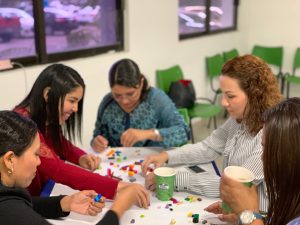 Fig. 1 Participants creating LEGO representations of themselves
Fig. 1 Participants creating LEGO representations of themselves 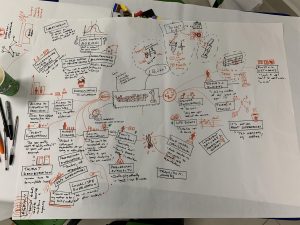 Fig. 2 A visual summary of the first workshop
Fig. 2 A visual summary of the first workshop
The starter event was a breakfast with a successful woman scientist and entrepreneur, Gabriela Leon. Gabriela, a biochemical engineer, has developed a nano-scale compound which destroys viruses and pathogens and which is highly effective in preventing the spread of infection even from Ebola. Women were invited from the universities based in Merida, the Centre for Scientific Research of Yucatan (CICY) and also STEM related organisations, such as Women Who Code. Hearing from a woman, who had made a scientific breakthrough and successfully turned this from an invention into an innovative product helped to set the agenda for the workshops to follow. Issues discussed were caring responsibilities, the need for supportive family situations and the perceived roles of women in society.
The sessions that followed over the next four days were run with; leaders of opinion: regional governmental and womens’ organisations as well as academics and business women. In each of these sessions design thinking techniques were used to build community, explore the experience of women in Yucatan and look for synergies and potential collaborations. The practical ‘hands on’ approach extended to the session with representatives from 5 different regional government organisations concerned with education, science and technology and business, where the focus was on the assistance that these organisations might give to women in STEM. Two sessions were also run with students, predominantly from UPP, these sessions also included some academics. As well as exploring their own experiences, the students were asked to design the key elements of an online platform for networking; one of the desired outcomes of the entire project.
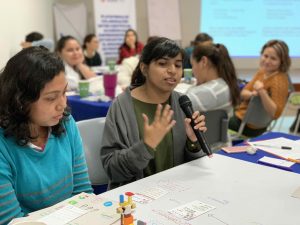 Fig. 3 Explaining an idea
Fig. 3 Explaining an idea
From the workshops a common thread emerged when the women present discussed their experiences, many stories were told of women, of all ages facing adversity. From students struggling against expectations through to refugees starting life in a new country, the common factor for all of these women was the support of at least one family member, encouraging them to pursue their academic interests and to study a STEM subject. The stories were very moving and their telling helped women to identify with one another and to connect at an emotional as well as cognitive level, this was facilitated by the use of LEGO, drawing and representation to ‘release’ the stories and free up the discussion. Encouraging head (cognitive), heart (emotional) and hands (practical) involvement proved once again to be a powerful approach to engaging diverse groups to find common ground, and, later, potential design solutions.
In both the student and leaders of opinion workshops the participants were asked to design the key affordances of a networking platform. The resulting ideas showed a desire to have a space in which to tell individual stories, either on profiles, or using video, and to make connections through assisting one another with help or information. The proposals from each of the sessions were displayed for the government representatives to see during their session.
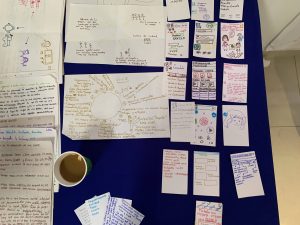 Fig. 4 Ideas on display
Fig. 4 Ideas on display
Early on in the planning of the workshops it was realised that the design of an online platform would not be the most significant outcome of the project. Instead, the process of telling stories and working together was realised to be a crucial part of building a women’s network. It was decided then, to run a pilot workshop adopting a similar approach to that taken in workshops on ‘problem solving in employment’, which had preceded the network focused workshops.
In the first meeting of leaders of opinion, when women had shared their stories and talked about their areas of work, one woman had talked about her work with Mayan beekeepers. The team considered the potential of all of the stories for further exploration by the group and this beekeeping case was selected. Yarelli, the project owner, was invited to present to the final meeting of the leaders of opinion; to identify problems that she, and the women she is working with, face; and to identify where help and support is needed. The women present then worked in groups to explore the problems and to identify potential solutions. This approach led to some fruitful connections being made, for example, with the Research Institute to aid with the validation and certification of the honey. However, the benefits of the discussion were not just for Yarelli but for all those present, working together on a real-world problem enabled the women to demonstrate and contribute their expertise and to get to know one another both professionally and socially, which is key to the forging of a network. The building of real-world connections in this way was seen, by the facilitators, as paramount to the success of any online networking platform.
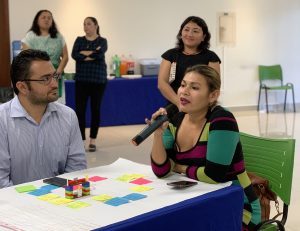 Fig. 5 Responding to the problem.
Fig. 5 Responding to the problem.
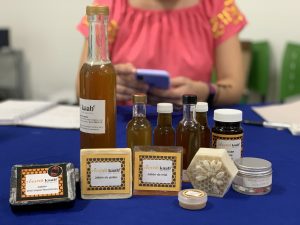 Fig. 6 Yucatecan honey products
Fig. 6 Yucatecan honey products
For each session surveys were conducted with participants to find out how the sessions, with their design thinking approach were received. The feedback was overwhelmingly positive about the approach and the opportunities that it brought. What stands out in the feedback is the value attributed to sharing stories and learning about others’ experiences and the obstacles that have been overcome.
The next step in the project is the continuation of networking events in parallel to the development of the online platform. The precise form that the platform will take is a subject for discussion and it is hoped that it will grow organically with the first step being the development of profile spaces where women can share their stories and requests for assistance from others.

Leave a Reply